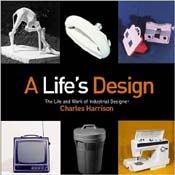Book review: A LIFE’S DESIGN: The Life And Work of Industrial Designer Charles Harrison

Before reading A Life’s Design: The Life and Work of Industrial Designer Charles Harrison, I had never really given much thought to the design of everyday utilitarian items such as clock radios, hair dryers & plastic trashcans. From time to time, I may have thought: “That’s so easy to use” or “Oh – that’s a clever feature – I wonder who thought of that” without really giving any credence to the fact that someone had really designed it.
And yet – someone did, and a great deal of the consumer product design of the mid-twentieth century was done by Charles Harrison. Indeed, Mr. Harrison spent decades designing for Sears, and reading his book is like taking a trip through the Sears catalogues of my youth – the 50s, 60s & 70s
Mr. Harrison was born in 1931 in Shreveport LA and grew up in Prairie View TX, the son of a professor at Southern University. When Charles was a young teenager, his father moved the family to Phoenix where he had secured a job teaching at an all-black high school. It was in Phoenix that Charles started to endure the racism that would confront him his entire working life.
After having lived in segregated housing & graduating from a segregated high school in Phoenix, he attended The City College of San Francisco. There he encountered two life-altering events: being one of about only 20 black students in an enrollment of approximately 1,000; and a Vocational Guidance course which suggested that his field of endeavor should be art.
Thus, after graduation from college, he sought to enter one of the only five schools in the U.S. that held accredited industrial design programs. He chose the School of the Art Institute of Chicago (SAIC). How did a poor black kid from 1940s Southern USA afford such a prestigious school? Harrison himself explains:
“In many Southern states, if a black student wanted to study a field that was not offered at a black college, the state would pay his tuition and transportation to go somewhere that did offer it. As long as I didn’t go to school in Texas, they didn’t care. They probably would have sent me to Paris or Rome! That’s how I was able to finance my undergraduate education. I entered the School of the Art Institute in 1949, on a four-year tuition and travel scholarship provided by the State of Texas.”
After working in small design firms where Harrison honed his skills, he was accepted in the industrial design department of Sears in 1961. He was the first black executive Sears ever hired in its Chicago headquarters and faced racism at work every day of his career.
Harrison’s portfolio is truly mind-boggling. The Dial-O-Matic Food Cutter. The View-Master 3-D viewer. Portable televisions and florescent lighting, hearing aids and bookshelves, band saws and wheelbarrows, cordless shavers and lawn tractors.
Industrial designers have traditionally considered a multitude of factors: is it easy to use? Does it fulfill its function? How does the design integrate with the “works” (for example inside a clock radio)? What materials are available to construct it? At what price? Do we need have a different material developed? Who can make this? What is their quality control? And many more, not the least of which is: Is it esthetically pleasing?
Good quality was available at reasonable prices. Today’s consumer products are often manufactured in China or other overseas locations where price is the main concern and quality control is not at all within the realm of the designer. In addition, many overseas manufacturers now design their own products. This has resulted in lower prices for many cheaply made consumer goods of questionable quality & design. That’s why the hand-mixer I received as a wedding gift in 1972 lasted until 2004 while its replacement conked out after a mere three years. (And had an `eject’ button in a most inconvenient place).
Harrison’s book opened my eyes to the beauty of many everyday objects and made me appreciate true design in those items that retain quality.
Who should read this?
· Every designer, industrial or otherwise, and any student thereof.
· Baby Boomers who remember the Sears catalogs of their younger days – and the products in their parents’ home from that catalog.
· People of younger generations who have grown up with many poorly designed items and who should understand why lowest price is not always the best selling point.
· And any young person, black or white, entering college & the workforce. It will open their eyes to how far America has come in being an accepting society.
I’m amazed at how much I learned and how much I enjoyed doing it. Read A Life’s Design: The Life and Work of Industrial Designer Charles Harrison. You’ll learn lots too, and meet a remarkable man and the legacy he left in American life.
A Life’s Design: The Life and Work of Industrial Designer Charles Harrison at Amazon.com
A Life’s Design: The Life and Work of Industrial Designer Charles Harrison at Amazon.ca
[tags]A Life’s Design: The Life and Work of Industrial Designer Charles Harrison, Charles Harrison, industrial design, Sears, Sears catalog, small appliances, SAIC, School of the Art Institute of Chicago, View-Master, Dial-O-Matic, black executives, Sears headquarters, racism in the workplace[tags]

[…] Read more here: A Life’s Design: The Life And Work of Industrial Designer Charles Harrison […]
[…] ExUrbanis placed an observative post today on A Lifeâ […]